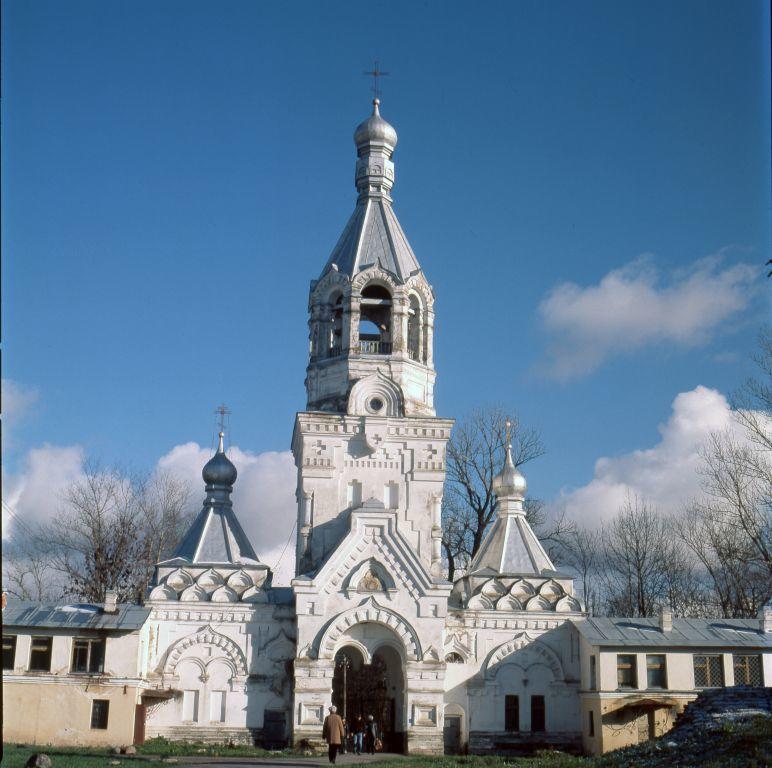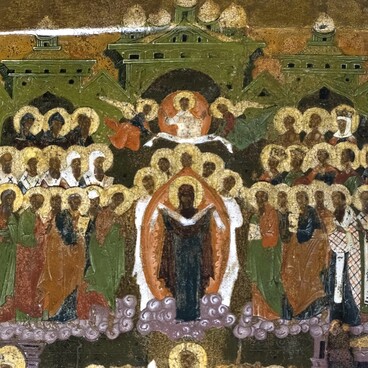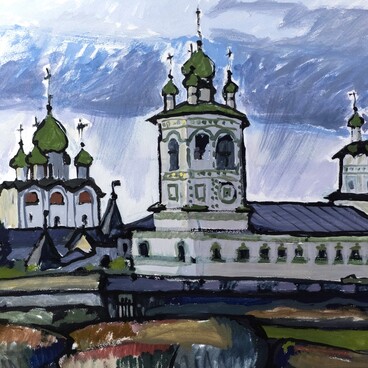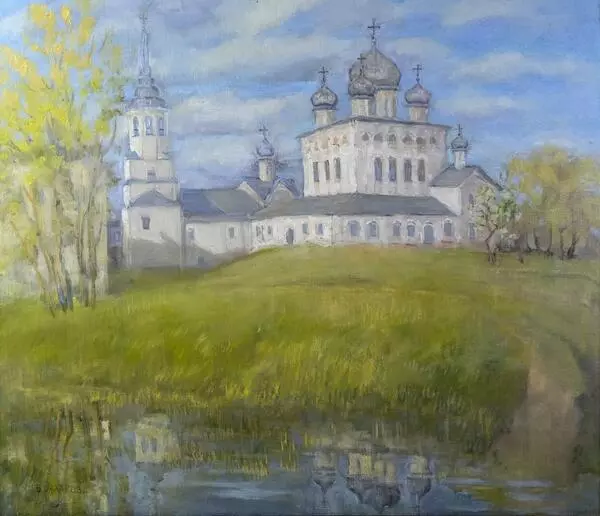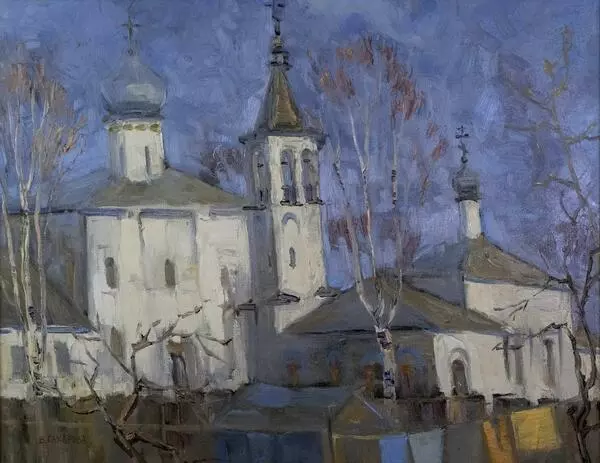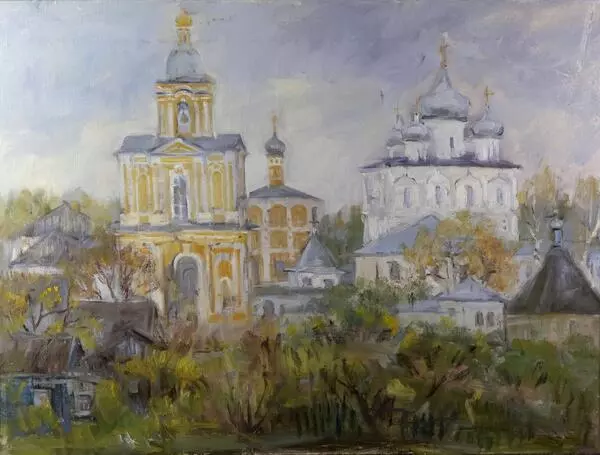In the Middle Ages, Novgorod consisted of five boroughs — “ends”. In the People’s (Potter’s) End near the fortifications around the Kremlin, there was a second-class (according to a system of classification of monasteries in Russia) Desyatinny Convent.
According to one hypothesis, Princess Theodosia Mstislavovna (in monasticism Euphrosyne) was its founder: she built the monastery in honor of the miraculous deliverance of Novgorod from the Suzdalians.
In 1170, Novgorod, then ruled by Prince Roman Mstislavich of Halych, was besieged by the troops of Mstislav Andreyevich (son of Prince Andrey Bogolyubsky) and his allies. The siege lasted several days. Archbishop John heard a voice commanding him to climb the fortress wall with an image of the Most Holy Theotokos. He fulfilled the command. An enemy arrow pierced the Face of the Mother of God; Her eyes filled with tears. Darkness immediately enveloped the Suzdalians, and they began to fight with each other.
Since that time, the Icon of the Theotokos, referred to as “Our Lady of the Sign”, has become especially revered. In chronicles, the monastery was first mentioned in connection with the year 1327, when the Church of the Nativity of the Blessed Virgin Mary was erected “on the Desyatina” (the monastery was founded on an estate previously owned by the princes of Novgorod called Desyatina) under Archbishop Moses.
Under the posadnik (mayor) Isaac Onkifov, a new Nativity Cathedral was erected (1397); in 1413, through the efforts of Ivan Morozov, a stone church of John the Baptist was built. Over time, a chapel, a refectory with a kvass room and stone cells were added. In 1809, a bell tower rose above the ensemble, and in 1820, the All Saints’ Church was built on the cemetery.
After the Swedish invasion in 1611–1617, of all the buildings of the monastery, only the Nativity Cathedral survived.
Since 1918, the territory of the monastery was given to the Novgorod Gubernatorial Extraordinary Commission (Cheka) and a State Political Directorate Department. Prisoners were kept in the basement of the Nativity Church; the abbot’s building served as a club for Cheka members. In 1929, the monastery cemetery and its church were demolished.
The Nativity Cathedral, which was damaged but survived the Great Patriotic War, was dismantled in the mid-20th century.
It was only in the 1970s and 1980s that urgent restoration work began, led by Ninel Nikolayevna Kuzmina, an architect and restorer.
Today, on the territory of the former monastery, one can see the bell tower and buildings with monastic cells, but the main cathedral is still in ruins. The buildings of the monastery were given over to art workshops and are used as museums.
Victoria Stanislavovna Sakharova is an artist, a teacher of painting and drawing, and a regular participant of regional and interregional exhibitions. Her paintings uniquely express the softness and lyricism of Russian nature.
According to one hypothesis, Princess Theodosia Mstislavovna (in monasticism Euphrosyne) was its founder: she built the monastery in honor of the miraculous deliverance of Novgorod from the Suzdalians.
In 1170, Novgorod, then ruled by Prince Roman Mstislavich of Halych, was besieged by the troops of Mstislav Andreyevich (son of Prince Andrey Bogolyubsky) and his allies. The siege lasted several days. Archbishop John heard a voice commanding him to climb the fortress wall with an image of the Most Holy Theotokos. He fulfilled the command. An enemy arrow pierced the Face of the Mother of God; Her eyes filled with tears. Darkness immediately enveloped the Suzdalians, and they began to fight with each other.
Since that time, the Icon of the Theotokos, referred to as “Our Lady of the Sign”, has become especially revered. In chronicles, the monastery was first mentioned in connection with the year 1327, when the Church of the Nativity of the Blessed Virgin Mary was erected “on the Desyatina” (the monastery was founded on an estate previously owned by the princes of Novgorod called Desyatina) under Archbishop Moses.
Under the posadnik (mayor) Isaac Onkifov, a new Nativity Cathedral was erected (1397); in 1413, through the efforts of Ivan Morozov, a stone church of John the Baptist was built. Over time, a chapel, a refectory with a kvass room and stone cells were added. In 1809, a bell tower rose above the ensemble, and in 1820, the All Saints’ Church was built on the cemetery.
After the Swedish invasion in 1611–1617, of all the buildings of the monastery, only the Nativity Cathedral survived.
Since 1918, the territory of the monastery was given to the Novgorod Gubernatorial Extraordinary Commission (Cheka) and a State Political Directorate Department. Prisoners were kept in the basement of the Nativity Church; the abbot’s building served as a club for Cheka members. In 1929, the monastery cemetery and its church were demolished.
The Nativity Cathedral, which was damaged but survived the Great Patriotic War, was dismantled in the mid-20th century.
It was only in the 1970s and 1980s that urgent restoration work began, led by Ninel Nikolayevna Kuzmina, an architect and restorer.
Today, on the territory of the former monastery, one can see the bell tower and buildings with monastic cells, but the main cathedral is still in ruins. The buildings of the monastery were given over to art workshops and are used as museums.
Victoria Stanislavovna Sakharova is an artist, a teacher of painting and drawing, and a regular participant of regional and interregional exhibitions. Her paintings uniquely express the softness and lyricism of Russian nature.

